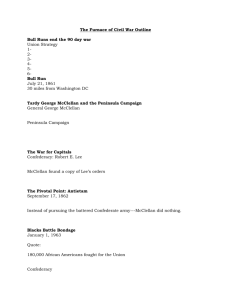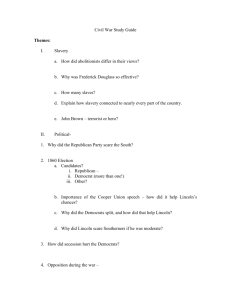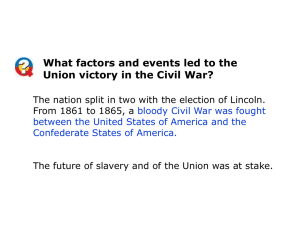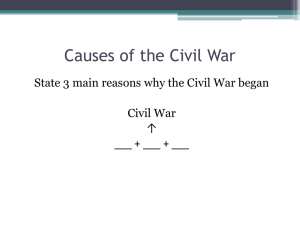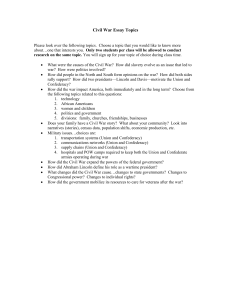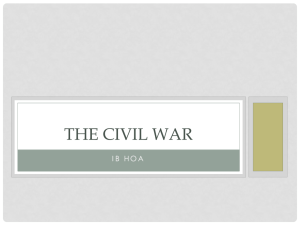APUSH Keys to Unit 5 Civil War
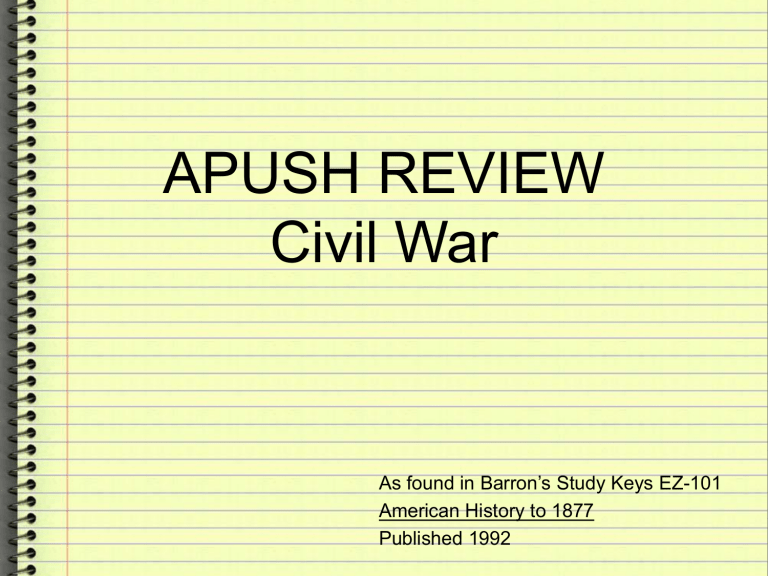
APUSH REVIEW
Civil War
As found in Barron’s Study Keys EZ-101
American History to 1877
Published 1992
Theme 12 Civil War
After the Southern states seceded, the federal gov’t sought to hold its forts on Southern soil and to keep border states from joining the Confederacy. The Union appeared to have formidable advantages at the outset of the fighting. The Confederate gov’t needed to mobilize a unified effort contrary to its states rights philosophy. The four-year military struggle brought drastic changes on the home fronts, including greatly increased power for the central gov’t. The Union’s naval blockade and success at minimizing foreign aid to the South were important factors in the outcome. The war to preserve the Union had also becomes the war to end slavery.
Theme 72: Civil War begins
Overview : The new Lincoln administration faced the problems of suppressing secession, of retaining the border states, and of protecting federal property in the South.
•
Inauguration: By Lincoln’s Inauguration, seven Southern states had already seceded from the Union
On the long train ride from Springfield the president-elect was hurried in disguise through Baltimore because of fears of assassination
• In his First Inaugural Lincoln emphasized that the Union was “perpetual”
1.
He promised not to interfere with slavery “in the States where it exists”
2.
He denied secessions’ legality
3.
He vowed to preserve the Union in the face of “insurrection”
Border slave states: Were a matter of concern to the Lincoln gov’t
• Delaware had few slaves, but Maryland’s secession could have surrounded Washington. Lincoln’s imposition of martial law and a pro-Union election result secured that key state
• Missouri was bitterly divided and became a battleground, particularly on the Arkansas border
• Kentucky attempted neutrality (it was both Lincoln’s and Davis’s state of birth), but Confederate armed intervention led to
Union countermeasures
Difficult choices of loyalty: Faced many (Robert E. Lee, for example) and literally divided some families
Fighting begins: Forts in the South at Pensacola, Florida and at Charleston, S.C. (Fort Sumter) were still in federal hands. Lincoln dispatched a relief ship with supplies for Sumter.
• On Confederate gov’t orders, Gen. Beauregard delivered an ultimatum and then opened fire on Sumter, which surrendered in
36 hours
• The next day Lincoln called for 75,000 militia (for 3 months) to suppress the rebellion and then proclaimed a blockade of rebel ports in the South
Theme 72: Civil War begins
The North : Appeared to have significant advantages at the beginning of the war
• The North had a population advantage of 22 million to 9 million (and over 3 to 1 of white males of military age)
• Over 90% of the nation’s manufacturing (including nearly all heavy industry) was located in the North
• The North (and the West) had diverse agriculture, which it was able to greatly expand
• The North had a great edge in capital wealth (even if the South’s slaves were included)
• Transportation systems (notably railroads) were far superior
• The North had nearly all the civilian shipping and most of the navy
• A more nationalistic, centralized gov’t structure was already in place (Lincoln turned out to be a notably effective wartime leader)
The South : Apparent advantages included:
• Slaves (1/3 of the population) freed more whites to fight
• A vast geographic area, familiar to its defenders, would presumably have to be invaded and conquered by the North
• Cotton exports could pressure textile-manufacturing Britain to provide aid
• The South had a strong military tradition
• Many veteran military leaders (including
Lee) remained loyal to the South (officers on both sides had served together in the Mexican War)
• The South was hampered by its commitment to states rights and localism (“excessive democracy”)
Theme 73: The Confederacy
Overview : to accomplish its “conservative revolution,” the South needed to create a new gov’t while pursuing the war effort
Confederate States of America: A gov’t was formed at Montgomery, Alabama in Feb. 1861
• Support for secession was strongest where slaveholding was most prevalent (yet 44% voted against secession in Alabama; and there were numerous pro-Union areas through the South)
• Jefferson Davis (Mississippi) was elected president 9for a single, six-year term) and Alexander Stephens (Georgia) vice president
• Delegates adopted a constitution, duplicating the U.S. Constitution in may respects , but with state sovereignty acknowledged. Slavery and transporting of slaves were protected; the president was given an “item veto”; protective tariffs were banned
• After Lincoln’s inauguration, Va and three other states joined the Confederacy; the capital was moved to Richmond in June
Problems: Political bickering hampered the South
• Each state was represented in a cabinet whose membership frequently changed
• Competing political parties never emerged
• The centralization of power necessary to conduct war conflicted with commitment to states rights (Georgia objected to
“military dictatorship,” for example)
Conscription Act (April 1862) Drafted white men aged 18-35 for three years
• Substitutes could be bought and many inequities existed
• Large slave-holders were exempted, causing class resentment
• Desertions became a major problem as the war progressed
• Slaves were used as laborers but were not armed until the war’s end
Financing the war:
• Taxes were inequitable and inadequate and were resisted; funds were raised by printing national and state bonds and paper currency
• Resultant inflation reached over 9,000% in four years (compared with 117% in the North)
• Refugees contributed to a growing food crisis, and in 1863 women led bread riots in several Southern cities
• Despite some success with blockade-running, there were shortages of everything
Theme 74: Bull Run to Chancellorsville (1861-63)
Overview : Early enthusiasm by both sides over the prospect of a short war was quickly shattered. Over
600,000 (2% of the population) died in four years of fighting
Union strategy: Stressed a naval blockade, gaining control of the Mississippi River, and military campaigns in eastern
Tennessee and against Richmond (the two capitals were only 100 miles apart)
Bull Run (Manassas, Va): The scene of the war’s initial major battle (July 21, 1861)
• Jackson stood like a “stone wall” as Confederate reinforcements arrived by railroad (illustrating technology’s impact)
• After the confused clash, Union soldiers (and civilian spectators) fled to Washington in panic
• Lincoln called for 100,000 troops for three years and appointed George McClellan general-in-chief
McClellan: Excelled at organizing troops and stirring enthusiasm
• Though fearful of risks, he was pressured to launch the Peninsula Campaign
• Slowly approaching Richmond, the Union Army of the Potomac won 4 of 5 battles and then retreated (McClellan was relieved by Lincoln)
Robert E Lee: Commander of Confederate Army of Northern Virginia
Shenandoah Valley (Virginia): Attacks by Jackson’s Confederates diverted attention from Richmond; General John Pope was replaced by McClellan after losing second battle of Bull Run to Lee
The West: General Ulysses S. Grant drove the Confederates from Kentucky then won key victories over Johnson at Forts Henry and Donelson in western Tennessee. At Shiloh (Tennessee) both sides suffered heavy casualties.
Antietam : Lee invaded Maryland (September 1862), where the Battle of Antietam (Sharpsburg) proved to be the war’s bloodiest day.
• McClellan failed to pursue Lee, but Lincoln followed the “victory” with the Emancipation Proclamation
Union defeats: Fredericksburg, Virginia (December) was a serious Union defeat, and at Chancellorsville in May, Lee maneuvered brilliantly but lost his able “right arm” Stonewall Jackson
Theme 75: Gettysburg to Appomatax (1863-65)
Overview : The third year of the war began with two key Union victories, followed by Sherman dividing the
Confederacy and the final siege of Richmond
Gettysburg: (July 1-3, 1863): After Chancellorsville, Lee decided to invade the North again
• Hopping to take Harrisburg and attack Washington from the north, Lee clashed by accident with the Army of the Potomac at
Gettysburg, Pennsylvania
• Pickett’s charge again illustrated the new defensive advantage (new bullets in breech-loaded rifles, for example)
• Meade failed to follow up as the Army of the Northern Virginia retreated south in the rain
Vicksburg : In Mississippi; fell the next day (July 4)
• Grant had outflanked the key city and besieged it for six weeks
• The Mississippi River was now in Union control, cutting off Confederate supplies from the West
War west of the Mississippi: Confederates and Unionists clashed in scattered small campaigns
• Texas troops were defeated in New Mexico (Glorieta Pass)
• Sioux Indian uprising in Minnesota escalated to a general plains war in the Dakotas
Tennessee: Union troops were besieged at Chattanooga
• A series of Union victories (November 1863) provided the base for William T. Sherman’s offensive
• Lincoln had at last found an aggressive general in Grant, who was called to the East
Georgia : Invaded by Sherman’s Army, using total war tactics
• Civilian support was undermined by systematic physical destruction
• Atlanta fell after a month-long siege (September 1864), and Sherman then reached the sea at Savannah (December 21)
• Living off the land, the Union army marched north, taking South Carolina’s capital and invading North Carolina by the war’s end
Theme 75: Gettysburg to Appomatax (1863-65)
Virginia: Grant, now general-inchief, pursued Lee’s army south through Virginia’s “Wilderness”
• Petersburg (south of Richmond) was reached after a series of battles.
• Lee’s outnumbered forces endured ten months of trench warfare before abandoning Petersburg
• Meanwhile, Sheridan’s Union cavalry was devastating the Shenandoah Valley, Lee’s “breadbasket”
End of war : Richmond was evacuated April 2. Lincoln visited the city and was acclaimed by free blacks
• Lee’s trapped and depleted army surrendered at Appomattox Court House on April 9
• Jefferson Davis was captured in Georgia a month later and imprisoned
• All other Confederate forces had surrendered by the end of May
The assassination of President Lincoln: Occurred at Ford’s Theatre five days after Appomattox.
• John Wilkes Booth, the assassin, was shot while fleeing through Virginia
• Four “conspirators” were quickly tried by a military commission and hanged in July
KEY FIGURES
Robert E. Lee: After declining Lincoln’s offer of command of the U.S. Army, he brilliantly led the Confederate Army of Northern
Virginia. After the war, he became president of Washington College, Virginia, now called Washington and Lee.
Ulysses S. Grant: Famed for his insistence on unconditional surrender at Ft. Donelson, he forcefully applied the advantages of the
North’s manpower and material, yet he offered generous terms to Lee at Appomattox.
Theme 76: Diplomacy and War at Sea
Overview : The Confederacy sought (and the Union sought to prevent) diplomatic recognition and aid from abroad. The war at sea affected these objectives.
A naval blockade: Of the South’s extensive coast; was declared by Lincoln at the war’s onset.
• To pressure Britain and France, the Confederacy attempted an embargo on cotton exports (“King Cotton diplomacy”)
• Reserve surpluses and alternate sources (Egypt and India) blunted the strategy
• England also relied on grain imports from the North
• The Union Navy secured most of the coast but blockade running continued
• United States policies on neutral rights on the high seas seemed to contradict its earlier principles.
The Trent Affair : In November 1861 a Union warship removed two Confederate Ambassadors (Mason and Slidell) from a British ship
(the Trent) off Cuba. Faced with a British ultimatum, Secretary of State Seward had the diplomats released and issued a statement of regret
Ironclads : In an effort to break the blockade, the Confederacy outfitted an ironclad, the Virginia (formally the Merrimack )
• After sinking many wooden vessels, it fought the Union ironclad Monito r to a draw (March 9, 1862)
• Smaller gunboats were used effectively by the Union in joint river operations
• Farragut’s fleet took New Orleans (Spring 1862) and Mobile (Summer 1864) using ironclads
• Securing the Mississippi River divide the Confederate armies
British aid: “Laird rams” (ironclads) and other vessels were built in Britain for the Confederacy
• For nearly two years the privateer Alabama and other raiders destroyed Union ships on the high seas
• American interests were ably handled in London by Ambassador Charles Francis Adams
• American diplomatic pressure finally forced Britain to halt the sale of ships
• An 1871 treaty arranged by Secretary of State Hamilton Fish settled the Alabama claims (for damages) with Britain
The Emancipation Proclamation: Assured that Britain and France would not support a pro-slavery Confederacy despite the impact the Union naval blockade had had on Britain’s textile mills and their employees
Napoleon III : Offered to mediate the war but his offer was spurned by the U.S. as “foreign intervention”
• French armies overthrew the Juarez gov’t of Mexico in June 1863
• A puppet gov’t was installed under Emperor Maximillian (April 1864)
• U.S. pressure helped cause France to abandon the Mexican adventure after the war (1867)
Theme 77: The Home Front
Overview : Civilian life, North and South, was significantly altered by the war, but political institutions showed remarkable continuity.
Economic impact: The economies of the North and the South, after an initial shock, were stimulated by the war
• War contracts brought prosperity, although workers’ wages did not match inflation
• Speculation, profiteering, and corruption were widespread - some materials were shoddy (of poor quality)
• The South became more urbanized, more industrialized, and, despite its states rights doctrine, more centralized politically and economically
• Northern factory workers became more unionized and more militant, despite employer resistance.
Women: Played a crucial role in the war effort, North and South
• Many went to work in fields and factories and in gov’t. Society became less patriarchal.
• Dorothea Dix, Superintendent of Nurses, and Clara Barton (later, a founder of the American Red Cross) recruited women for hospital work in the North.
• Dr. Elizabeth Blackwell, first woman medical school graduate, helped persuade the War Department to create the U.S.
Sanitary Commission , which coordinated volunteer groups
• Many women teachers with the Freedmen’s Aid Commission followed Union troops into liberated areas
The political process : Went on despite the war
• Congressional elections were held in the North (1862) and South (1863)
• Lincoln’s reelection in 1864 was interpreted as a referendum on the war
• Lincoln effectively mobilized the metaphor and Biblical intonation his wartime speeches. The self-educated president’s mastery of language is especially notable in the Gettysburg Address (November 19, 1863), where the concept of national unity was stressed
• The Second Inaugural (March 4, 1865) declared “Malice toward none; charity for all.”
Theme 78: Civil rights and Civil war
Overview : Paradoxically, President Lincoln found it necessary to restrict some civil liberties to gain security and to save the Union and its democratic institutions
Wartime government: Congress did not reconvene until July 1861 enabling Lincoln to attempt to suppress the insurrection through the use of presidential war powers
• Lincoln imposed martial law after a riot in Baltimore, had some Confederate sympathizers jailed, and suspended the writ of habeas corpus.
• Chief Justice Taney, sitting circuit, ruled in ex parte Merryman (1861) that Lincoln had acted unconstitutionally, but the president ignored the ruling
• After the war, in ex parte Milligan (1866) the Court struck down the wartime conviction of a civilian by a military tribunal.
Peace Democrats: Opposed continuation of the war. The extreme “disloyal” faction was branded Copperheads.
• Congressman Clement Vallandigham (Ohio), a leading critic, was arrested, exiled to the Confederacy, and then returned by way of Canada
• Democrats, aided by war weariness, made significant gains in the 1862 Congressional elections
• Ex-general George McClellan, Democratic presidential candidate, in 1864, distanced himself from their peace platform
• During the war, several thousand dissenters were imprisoned for suspected disloyalty and several hundred newspapers were suppressed for various periods of time
• Republican Radicals on the Joint Committee on the Conduct of the War pressed for more vigorous efforts
Conscription : Inequities contributed to public unrest
• It was possible to purchase a substitute or pay for an exemption
• After the Emancipation Proclamation some poor urban immigrants feared future job competition from blacks
• Anti-draft riots, with strong racist tone, in New York City (and elsewhere) were suppressed by federal troops (July 1863)
Theme 79: Free at Last!
Overview : Black involvement in the war helped change the Union’s objectives but full emancipation came only with a constitutional amendment.
Preservation of the Union: Had been Lincoln’s avowed objective as the “rebellion” began, but he also saw slavery as a moral evil and a threat to white labor.
• He had considered gradual emancipation and colonization abroad
• Concern over the broader states restrained emancipation early in the war
Congress : Took the initiative
• The Confiscation Act of August 1861 encouraged slave (“contraband”) to escape
• In April 1862 Congress abolished slavery in the District of Columbia and, in June, in the Western territories.
The Emancipation Proclamation (effective January 1, 1863): Based on “military necessity”
• It freed slaves in areas in rebellion but not in areas controlled by the Union. Therefore, not one slave was immediately freed.
• The war’s purpose now took on a moral tone
• British and French diplomatic recognition of the Confederacy was now unlikely
Blacks: Not accepted into the military initially, they became important in the Union war effort
• After Congress authorized recruitment (1862), over 185,000 blacks served in the navy and army (85% of those eligible; 10% of the Union Army). They won 23 Congressional Medals of Honor.
• Blacks desired combat but were often given menial tasks ( and were paid less until 1864). All their officers were white
• Colonel Robert Gould Shaw’s 54th Massachusetts (black) Regiment stormed Ft. Wagner (South Carolina), suffering 40% casualties. Other black units served with distinction
• There were incidents of anti-black racial violence and discrimination in the North
Emancipation : Was finally secured by passage of the 13th Amendment.
• At Lincoln’s urging, the proposal was included in the 1864 Republican Platform
• The ratification process was completed in December 1865.
Theme 80: A “New Revolution”
Overview : The American Civil War brought revolutionary changes in warfare, but more important, produced significant economic and political changes in the country.
The first modern war: Produced a revolution in military technology and strengthened defense.
• Firepower was greatly enhanced (in range, accuracy, and rate of fire)
• Breech-loading rifles, repeating carbines, and the Burton bullet were patented.
• The Ordinance Bureau helped transform American industry. Arsenals applied machinery to processes (the American system), which were widely copied abroad.
• The war accelerated the use of new civilian technology:
1.
McCormick’s reaper helped provide needed grain
2.
Singer’s sewing machine facilitated the production of uniforms
3.
Machines turned out inexpensive shoes, for both the military and civilians. Standardized sizes were adopted.
4.
Mass markets for manufactured goods at reduced prices developed.
Economic legislation : Blocked by the South before the war, was now passed by Congress (most of it in 1862)
• An excise tax and the first graduate income tax were enacted to help finance the war
• Congress authorized a limited issue of new paper currency (greenbacks)
• The national Banking Acts stimulated sale of government bonds
• Higher protective tariffs were enacted (average rates were doubles)
• The Homestead Act provided 160 acres of free land to settlers who resided on it for five years
• Chartering and funding began for a transcontinental railroad .
• The Morrill Land Grant Act encouraged the establishment of state universities
• The 1864 Contract Labor Act assisted the importing of immigrant labor
Republican Party: the coalition of free labor, western agriculture, and eastern business was strengthened by the above legislation
Government and business: Became closely allied. The government vastly increased its direct impact on individual citizens
